Hernia of the lower eyelid Is a pathological condition of epithelial tissues located in the lower part of the orbit. As the tone of the muscles in the circumference of the organ of vision decreases, the skin stretches and sags.
The mechanism of formation of a hernia of the lower eyelid is that in the subcutaneous layer of the lower part of the eye fat deposits arrive, the accumulation of which leads to the appearance of a volumetric bulge in the form crescent moon.
A visual examination of a patient with signs of this ophthalmic disease gives the impression that a person has large bags under one or immediately under both eyes. The presence of this pathology is very difficult to hide with the help of cosmetics, while photographing a face or communicating with friends.
A hernia of the lower eyelid may have a congenital etiology or is the result of a previous injury, a chronic disease of the skin or internal organs. The appearance of this formation in the lower part of the eye is considered a long process, the occurrence which is preceded by long-term changes in the structure of epithelial and muscle tissues in circle of the century.
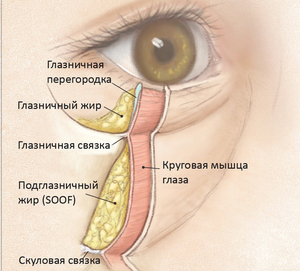
Studying a photo of a person suffering from a hernia of the lower eyelid, you can find abnormal swelling of this part face, which is accompanied by tearing, the presence of redness of the skin and mucous membrane of the organ vision.
Record content:
-
1 Stages and degrees
- 1.1 First degree of severity
- 1.2 Second degree of severity
- 1.3 Third degree of severity
- 1.4 Fourth degree of severity
- 2 Symptoms and Signs
-
3 Causes
- 3.1 Negative inheritance
- 3.2 Age changes
- 3.3 Chronic fatigue syndrome
- 3.4 Endocrine diseases
- 3.5 Stressful situations and lack of sleep
- 3.6 Bad habits
- 3.7 Associated diseases
- 4 Diagnostics
-
5 Treatment methods
- 5.1 Microcurrent treatment
- 5.2 Tightening with mesothreads
- 5.3 Blepharoplasty
- 5.4 Laser therapy
- 6 Possible consequences and complications
- 7 Video about hernia of the eyelids
Stages and degrees
A hernia of the lower eyelid is a pronounced cosmetic defect that not only reduces the quality of human life, but also causes painful symptoms.
The manifestation of signs of a pathological state of tissues is expressed in a dysfunction of the lacrimal canal, an increase in the risk of developing inflammatory processes. Depending on the clinical symptoms, changes in the structure of muscle and epithelial tissues, there are 4 main stages of a hernia of the lower eyelid.
First degree of severity
The sagging of the skin of the lower eyelid, as well as the weakening of the muscle tissues responsible for facial expressions, has an exclusively local manifestation. The patient has a slight bulge under the eye, which does not extend to the adjacent areas of the face.
Depending on the lifestyle of a person, the characteristics of his diet and working conditions, a hernia may acquire more pronounced signs, or it may become less noticeable. At the 1st stage of the formation of fatty deposits of this type, the cosmetic defect of the face does not create significant discomfort, but at the same time its progression continues and a gradual increase in volumes.
Second degree of severity
Hernia of the lower eyelid (a photo of this pathology displays the main signs of changes in the structure of epithelial tissues) 2 degrees is no longer just a cosmetic defect, but a disease that disrupts the work of the muscles faces. An increase in fatty growth under the eye leads to the fact that there is a loss of elasticity of the circular muscle of the eyeball.
A saccular bulge separates the organ of vision from the cheek. In especially severe cases with the rapid progression of this disease, there is a prolapse of soft tissues located in the buccal region of the facial disc.
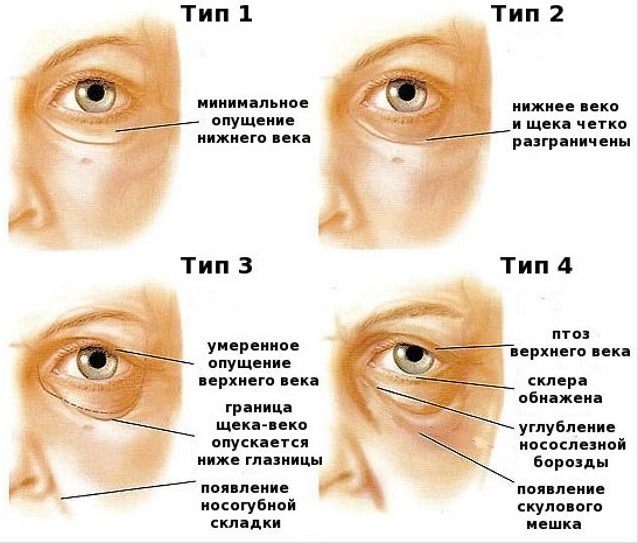
Such a development of pathological symptoms leads to general changes in appearance. The skin in the lower part of the eyelids and cheeks becomes obese, the person loses its former attractiveness.
Third degree of severity
At this stage in the development of a hernia of the lower eyelid, sagging of the adjacent epithelial tissues occurs, a decrease in the tone of the muscles responsible for facial expressions at the time of experiencing certain emotions. Patients with a 3 degree of severity of this pathology are faced with drooping of the eyebrows, cheeks, as well as the skin located in the region of the zygomatic-orbital joints.
A distinctive feature of this stage of hernia development is that the disease spreads to the upper part of the eyelid, provoking negative changes in the tissues of this part of the face.
Fourth degree of severity
A hernia of the lower eyelid (a photo of a cosmetic defect confirms its very close location near the eyeball) can provoke serious complications and negative changes in the circumference of the eye.
At this stage of the development of the disease, the outer corners of the eyes descend, the nasolacrimal grooves deepen into the lower layers of skin, zygomatic sacs are formed, which cannot be hidden with the help of cosmetics or any other ways.
Hernia of the lower eyelid of the 4th degree of severity ends with exposure of the sclera, irreversible changes in tissues that function as a physiological barrier between the outer layer of the skin and the mucous membrane eyes. Treatment of this stage of the disease requires the use of radical methods of therapy in the form of surgery.
Symptoms and Signs
The manifestation of a hernia of the lower eyelid is easily detected by external examination of the skin located in the circumference of the eyes.
This pathology is characterized by the following symptoms:
- large bags under the eyes;
- severe swelling of the epithelial tissues located between the ciliary row and the upper part of the cheek;
- excessive softness of the skin, which has signs of increased bulge (the presence of this symptom is explained by the fact that the subcutaneous space of this area of the face is filled with fatty deposits);
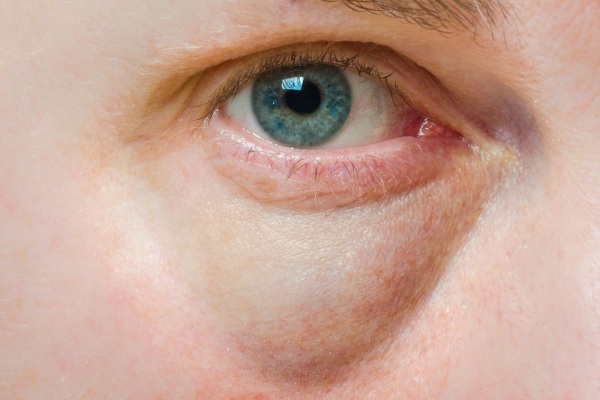
- narrowing of the field of view, which is expressed in the difficulties of visual inspection of environmental objects located at the same level with the ground;
- sagging skin in the eye area with a gradual spread of the pathological process to epithelial tissues of the cheeks and the contours of the zygomatic-orbital joints (this symptomatology manifests itself as the disease);
- dark circles under the eyes, which are more pronounced in the morning, as well as during those periods when a person is most tired;
- an increase in body fat in size, which immediately affects the appearance of a person (people with similar cosmetic defects look older than their age, a visual impression is created that they have a more voluminous and a round face);
- decreased elasticity of the muscles located in the lower eyelid.
A hernia of the lower eyelid (a photo of this pathology reflects the complexity of negative changes in this part of the face) does not appear only external symptoms, but also disrupts the work of the lacrimal canal, from which voluntary leakage occurs liquids.
Causes
There are congenital and acquired causes of a hernia of the lower eyelid. Moreover, this pathology can manifest itself at any stage of a person's life. This cosmetic defect is most often found in men and women over 45 years old who lead an active lifestyle, work a lot, devote insufficient time to complete recreation.
Negative inheritance
Genetic predisposition is the factor, the influence of which leads to the appearance of a congenital hernia of the lower eyelid. In this case, the child may initially have a tendency to sagging epithelial tissues and a decrease in the elasticity of the muscles in this part of the face.
The formation of bags under the eyes becomes more noticeable as the child matures and reaches puberty. A genetic predisposition to the formation of a hernia of the lower eyelid may appear at a more mature age. For example, at 30, 40 or 50 years old.
A distinctive feature of the effect of this causative factor is that the formation of bags in a person occurs in the same period of life, as in his blood relative, who transmitted pathological genes.
Age changes
Even regular care of the skin surface located in the periorbital region is not able to stop the natural aging of epithelial tissues with a gradual weakening of muscle tone.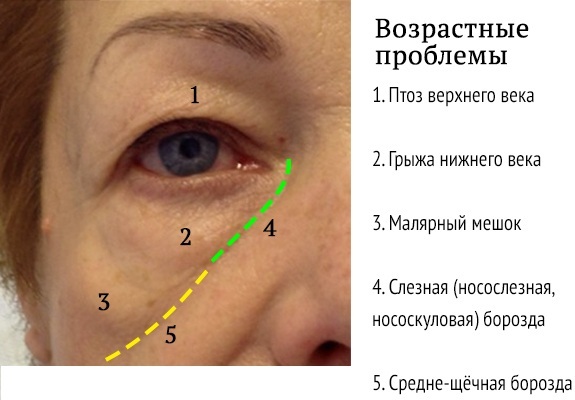
During the manifestation of emotions, accompanied by active facial expressions, blinking, the ligamentous apparatus, a free subcutaneous space appears, which is gradually filled with fatty deposits. Men and women of the older age group are at risk.
Chronic fatigue syndrome
People who work hard, do not provide their bodies with adequate rest, are much more likely to experience symptoms of a hernia of the lower eyelid. This reason for the pathological condition of the eye tissues is associated with the fact that the muscles of the periorbital zone are constantly in tension.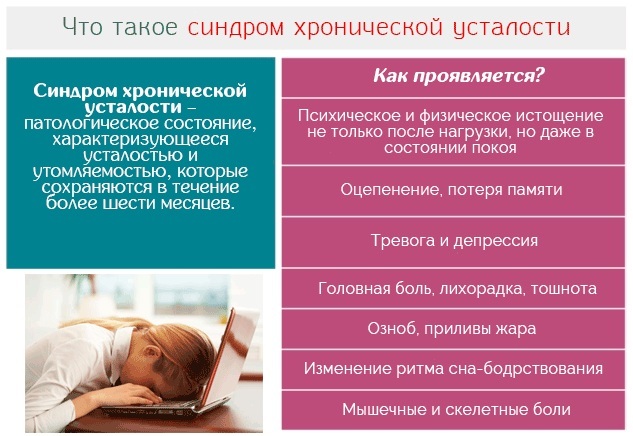
The result of constant fatigue is a premature loss of facial muscle tone, rapid aging, the appearance of not only bags under the eyes, but also deep expression lines.
Endocrine diseases
Violation of the physiological balance of hormones, concomitant diseases of the organs of the endocrine system also cause the appearance of a hernia of the lower eyelid. In this case, it is necessary to pay special attention to the functional state of the thyroid gland, adrenal cortex, ovaries in women. Especially if the painful condition of these organs was previously diagnosed in blood relatives.
Stressful situations and lack of sleep
Frequent stress and sleep disturbance leads to wear of the muscles of the periorbital zone of the face. In addition to the cosmetic defect in the form of a hernia of the lower eyelid, mimic wrinkles located on the outside of the corners of the eyes are attached.
Bad habits
Alcohol abuse, smoking, taking drugs - these are pathological addictions that cause premature weakening of the muscles of the periorbital part of the face.
Under the influence of these causal factors, a more active destruction of the ligamentous apparatus occurs, which is responsible for maintaining the elasticity of the muscles of the lower eyelid. In people who abuse alcohol and drugs, bulky bags of gray or dark blue form under the eyes.
Associated diseases
There are diseases of the cardiovascular, excretory and visual systems, one of the symptoms of which is the formation of a hernia of the lower eyelid. For example, inflammatory processes in the tissues of the kidneys, heart failure, or infection of the eyeball with infectious microorganisms.
Diagnostics
A hernia of the lower eyelid (a photo of the patient's face shows the complexity of this cosmetological defect) is a disease of epithelial tissues and musculature of the face, which is diagnosed by an ophthalmologist with the possible participation of such specialists as a dermatologist, a plastic surgeon, cosmetologist.
The table below describes the main types of examinations that need to be performed for patients with signs of a hernia of the lower eyelid.
| Diagnostic method | Description of the examination procedure and its cost |
| Visual inspection | Examination of a patient with signs of a hernia of the lower eyelid begins with a visual examination of his face and organ of vision. The doctor conducts a comparative description of this disease with signs of other pathologies that have similar manifestations. In the presence of objective suspicions of a hernia of the lower eyelid, the patient is assigned to undergo laboratory and instrumental diagnostics. |
| Ultrasound | An ultrasound examination of the lower eyelid area of the face shows an accumulation of adipose tissue that has filled the subcutaneous space with signs of sagging. This type of diagnostics is considered one of the most informative, and its average cost is 900 rubles. |
| MRI | MRI of the head with a detailed study of the tissue structure in the lower eyelid region makes it possible to determine the severity of pathological changes, to exclude the tumor neoplasm factor. The use of this method of hardware diagnostics is advisable in complicated cases, when the consequences hernias affected adjacent tissues in the circumference of the eye, led to exposure of the sclera, local inflammatory processes. The average cost of this type of examination is within 5500 rubles. |
| Blood analysis | A biochemical analysis of venous blood is performed in order to establish the cause of pathological changes in the tissues of the lower eyelid. In this case, the doctor checks the patient's body for the possible presence of endocrine disorders, infectious microorganisms, degenerated cells. The average cost of a biochemical analysis of venous blood is 520 rubles. |
Based on the results of a comprehensive examination, the attending physician makes a final diagnosis, and then forms an effective course of therapy. If signs of deterioration in visual acuity are detected, measures are taken to restore the functions of the eyeball.
Treatment methods
The formation of a fatty hernia in the periorbital zone of the face is an irreversible process that progresses with the aging of the human body. In order to prevent further changes in the structure of the epithelial and muscle tissues of the lower eyelid, it is necessary to establish the cause that caused the development of the cosmetic defect.
Currently, there are a large number of methods of non-invasive and surgical therapy aimed at removing a fatty hernia in the lower eyelid.
Microcurrent treatment
Microcurrent therapy consists in the fact that with the help of special equipment, the tissues of the periorbital zone of the face are affected pulses of electric current, the amplitude of which is in the frequency range from 0.1 to 300 Hz and voltage in the range from 11 to 14 B.
Treatment of fatty hernias of the lower eyelid using this method allows you to achieve the following effect:
- eliminate swelling;
- relax the spasmodic muscles of the periorbital part of the face;
- improve local blood circulation;
- provide high-quality lymphatic drainage.
Treatment with microcurrents is one of the areas of physiotherapy. The use of this method of eliminating bags under the eyes is advisable at the initial stage of the development of the disease, when the first prerequisites for the formation of a fatty hernia appear. Microcurrent therapy is completely painless and does not require the use of local anesthesia.
Tightening with mesothreads
Smoothing fat deposits in the lower eyelids with mesothreads is a modern and effective way to combat age-related changes in the structure of epithelial tissues.
Therapy with cosmetic threads for a facelift is as follows:
- The patient passes into the sterile conditions of the manipulation room, and then sits down in a chair.
- The cosmetologist performs antiseptic treatment of the skin surface of the cheeks and the circumference of the eyes.
- Then, with the help of injections, mesothreads are introduced into the subcutaneous space, which stretch the epithelial tissues and muscles of the periorbital zone of the face, which have signs of loss of elasticity, as well as sagging.
- The final stage of smoothing the skin in the area of hernia formation is the reprocessing of the tissues at the puncture sites.
The variety of mesothreads that are advisable to use in a specific clinical case is selected by a cosmetologist. Depending on the severity of the cosmetic defect, permanent or dissolving threads are used.
Blepharoplasty
Blepharoplasty is a surgical procedure aimed at removing fat deposits while simultaneously tightening muscle tissue.
This method of treating a hernia of the lower eyelid is as follows:
- The patient is brought into the sterile conditions of the surgical room.
- The patient receives antiseptic treatment of the skin around the eyes, local or general anesthesia, depending on the severity of the pathology and the extent of the operated area.
- A plastic surgeon makes an incision in the hernial sac, inside of which fat deposits are concentrated.
- After that, the doctor removes the lipid tissue, which creates the effect of skin bulging in the periorbital zone of the face.
- Then the doctor performs suturing of the operated tissues with tightening of the muscles that have lost their previous elasticity.
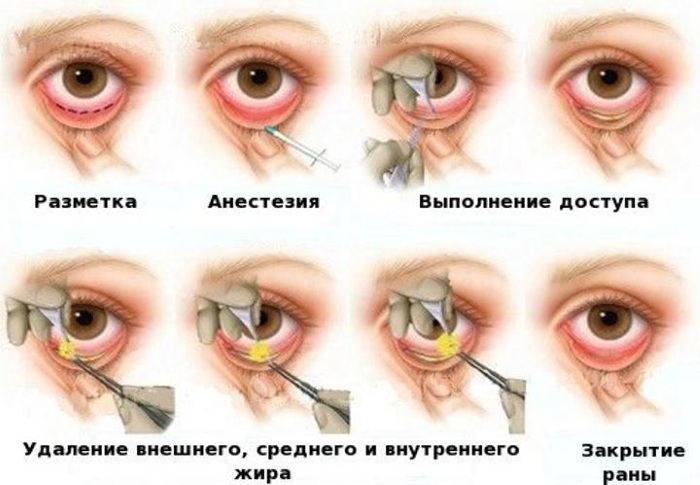
After the suture is applied, an antiseptic is applied to the skin surface of the periorbital area of the face to prevent wound infection. The patient is transferred to the general ward of the inpatient department of plastic surgery, where within 3 is under the supervision of medical personnel for 24 hours, receives care for the operated area faces.
The average time for complete rehabilitation and tissue healing is 8-10 days.
The advantage of the method of surgical treatment of a hernia of the lower eyelid is an excellent therapeutic effect for the complete removal of adipose tissue. The achieved result is saved for the rest of your life.
Laser therapy
This method of eliminating a fatty hernia in the lower part of the eyelid is carried out according to the same principle as blepharoplasty, but using special equipment. The attending physician does not use traditional surgical instruments, but a laser, with the help of which accumulations of adipose tissue are removed.
This therapeutic procedure is performed under the influence of local anesthesia. The main advantage of laser treatment of a hernia of the lower eyelid is the safety of this operation, the absence of deep cuts and scars, and rapid regeneration of damaged tissues.
Possible consequences and complications
A hernia of the lower eyelid is not a particularly dangerous disease that can pose a significant threat to the patient's health.
The presence of this cosmetological defect can provoke the following consequences and complications:
- decreased visual acuity;
- inflammation of the mucous membrane of the eye;
- deterioration in the quality of life due to a constantly present defect;
- the appearance of an inferiority complex;
- severe weakness of the lacrimal canal;
- reduction of the field of view.
A hernia of the lower eyelid is a pathological condition of the tissues of the periorbital zone of the face, which occurs due to sagging skin and weakening of muscle tone. The appearance of this formation is associated with the gradual filling of the subcutaneous space with fatty deposits.
A hernia of the lower eyelid can be detected by visual examination of a person's face live or from a photograph. A fatty hernia located in this part of the face is removed with the help of cosmetic products according to tissue tightening, mesothreads, microcurrent therapy, or surgical operations.
Video about hernia of the eyelids
Hernia under the eyes - remove or move:



